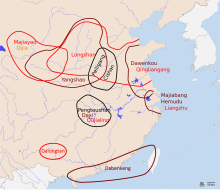Banshan
Appearance
 | |
| Geographical range | China |
|---|---|
| Period | Neolithic China |
| Dates | c. 2600 – c. 2300 BC |
| Type site | Banshan |
| Preceded by | Majiayao culture |
| Followed by | Longshan culture |
Banshan was a phase of the Chinese Neolithic Yangshao culture, c. 2600 to 2300 BC. The Banshan site is in Guanghe County, Gansu.
In 1923 and 1924, Swedish scholar J. G. Anderson discovered the sites of Banshan, Majiayao, Machang, Qijia and Xindian at Lajia on the north bank of the Yellow River.[1]
Gallery
-
Human head, part of urn from the Banshan phase of the Yangshao culture
-
Painted pottery jug from the Banshan phase of the Yangshao culture
References
Wikimedia Commons has media related to Banshan phase.
- ^ "Archived copy". Archived from the original on 2011-07-16. Retrieved 2009-09-22.
{{cite web}}: Unknown parameter|deadurl=ignored (|url-status=suggested) (help)CS1 maint: archived copy as title (link) Chinese Archaeology


